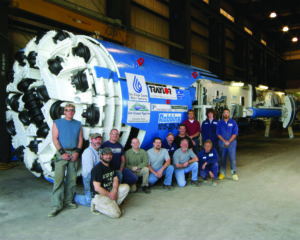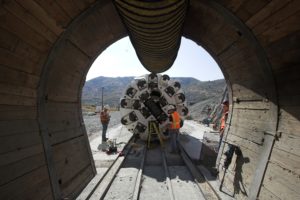![65 Years of Innovation and Experience [default]](https://www.robbinstbm.com/wp-content/uploads/2017/04/Side-Bar-Blue-Blocks_70-Years.jpg)
A Solution for Every Condition: Search our Project Database
Project Map
FEATURED PRODUCT: CROSSOVER MACHINES
Our History
A Legacy of Innovation
Information 24/7
News & Media
Insights in the Industry:
Read the Robbins Blog
 The San Vicente Pipeline, 17.7 km (11 mi) in length, connects the San Vicente Reservoir in Lakeside, California to the San Diego County Water Authority Second Aqueduct. The pipeline is part of the Water Authority’s Emergency Storage Project that will provide water to the city in the event of a drought or major earthquake.
The San Vicente Pipeline, 17.7 km (11 mi) in length, connects the San Vicente Reservoir in Lakeside, California to the San Diego County Water Authority Second Aqueduct. The pipeline is part of the Water Authority’s Emergency Storage Project that will provide water to the city in the event of a drought or major earthquake.
Project owner San Diego County Water Authority awarded the construction contract to the Traylor-Shea joint venture. The contractor chose a 3.5 m (11.5 ft) diameter Robbins Main Beam TBM and back-up system for two sections of tunnel at opposite ends, totaling about 2.75 km (1.70 mi) in length.
Due to the varying geology, multiple tunneling methods were chosen for the project. Two open-face digger shields were chosen to mine in conglomerates, while the TBM is mining in sections of rock at either end of the tunnel. The TBM-driven pass through granitic rock geology with a UCS of 140-345 MPa (2050 si).Drill and blast excavation is also being used in sections that interface the rock and conglomerate.
The refurbished TBM features 17 inch (432 mm) cutters and can generate a thrust of 6,005 kN (1,350,000 lb). The machine also has a maximum torque of 1,056,546 N-m (779,268 lb-ft) at the cutterhead. The Robbins back-up system consists of 11 decks and muck is being removed via muck cars.
 Boring began on June 21, 2006 after an onsite TBM assembly of only 30 working days. The machine excavated a 1.2 (0.7 mi) section west of the San Vicente Portal. and was then slated for an additional 400 m (1300 ft) section in weathered granite with clay seams. The Traylor-Shea JV slowed rotation of the cutterhead in order to bore through the mixed face and avoid clogging of the muck buckets. Excavation of the section using the TBM, rather than drill and blast, saved approximately 120 days on the construction schedule. The machine was then removed and re-launched at the West shaft where it will bore 1.3 km (0.8 mi) east. The machine excavated in granite requiring steel ribs and rock bolts, and completed its second section in April 2008.
Boring began on June 21, 2006 after an onsite TBM assembly of only 30 working days. The machine excavated a 1.2 (0.7 mi) section west of the San Vicente Portal. and was then slated for an additional 400 m (1300 ft) section in weathered granite with clay seams. The Traylor-Shea JV slowed rotation of the cutterhead in order to bore through the mixed face and avoid clogging of the muck buckets. Excavation of the section using the TBM, rather than drill and blast, saved approximately 120 days on the construction schedule. The machine was then removed and re-launched at the West shaft where it will bore 1.3 km (0.8 mi) east. The machine excavated in granite requiring steel ribs and rock bolts, and completed its second section in April 2008.

 Close
Close